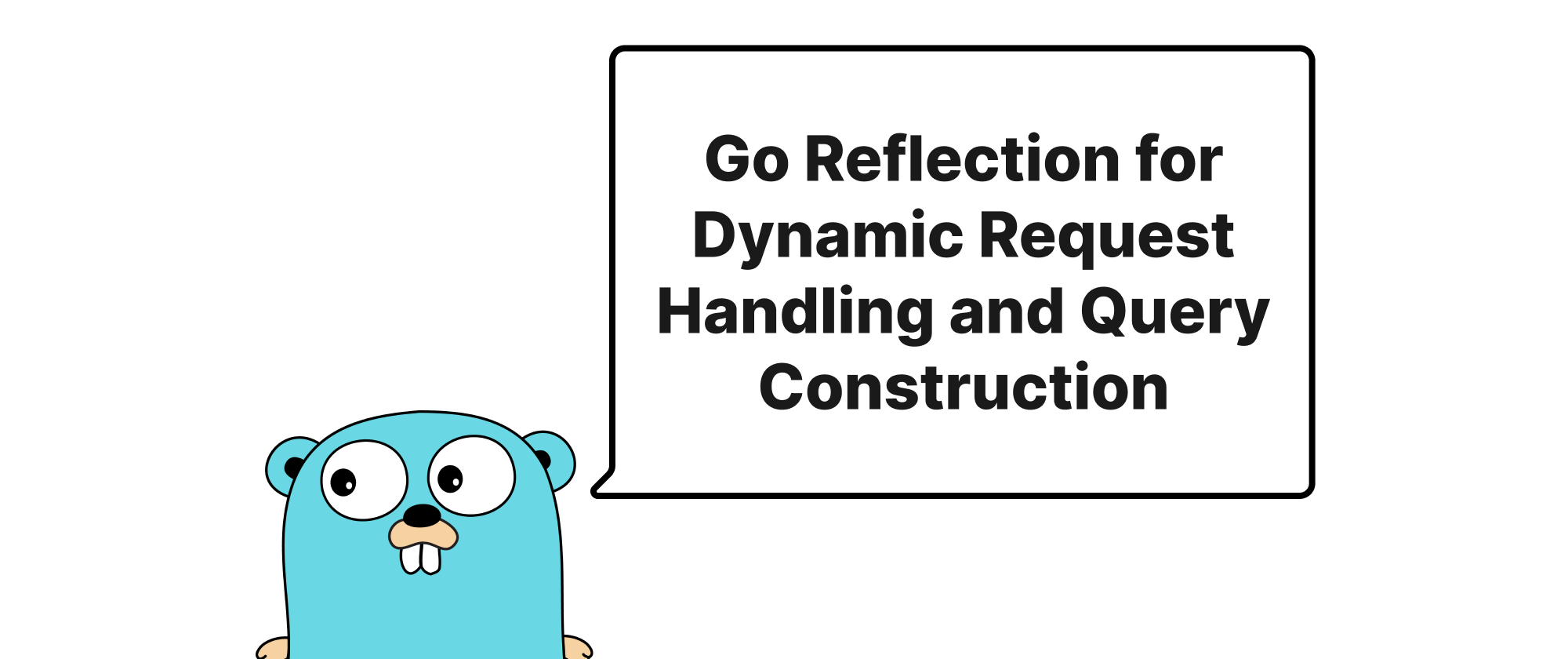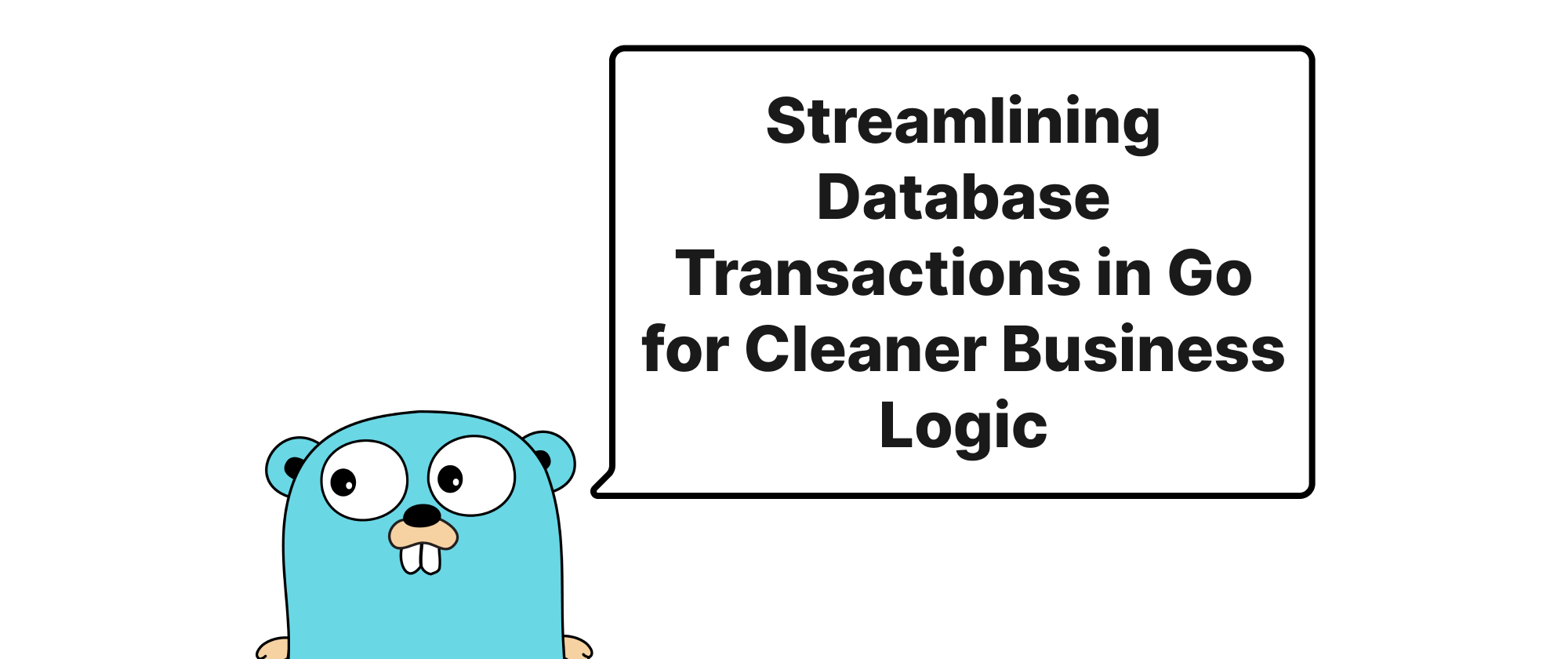Go Reflection for Dynamic Request Handling and Query Construction
Ethan Miller
Product Engineer · Leapcell

Introduction
In the world of web services and data-driven applications, handling diverse client requests and interacting with databases in a flexible yet efficient manner is a perpetual challenge. Often, we find ourselves writing repetitive code to parse request parameters, map them to internal data structures, or construct intricate database queries based on varying input. This boilerplate can quickly become a maintenance nightmare as applications grow. What if there was a way to make these processes more dynamic, adaptable to changing requirements without constant code modifications? This is where Go's powerful reflection capabilities come into play. By leveraging reflection, developers can write more generic and extensible code that can introspect and manipulate types at runtime, thereby streamlining the dynamic parsing of request parameters and the intelligent construction of database queries. This article delves into the practical application of Go reflection to achieve these dynamic behaviors, demonstrating how it can lead to cleaner, more maintainable, and highly adaptable software.
Understanding Go Reflection Fundamentals
Before diving into dynamic request parsing and query building, it's crucial to grasp a few core reflection concepts in Go. Reflection is the ability of a program to examine and modify its own structure and behavior at runtime. In Go, reflection primarily revolves around three types: reflect.Type, reflect.Value, and reflect.Kind.
reflect.Type: Represents the static type of a Go value. You can obtain it usingreflect.TypeOf(i interface{}). It provides information like the type's name, kind, methods, and fields.reflect.Value: Represents the dynamic value of a Go variable. You can obtain it usingreflect.ValueOf(i interface{}). It allows you to inspect and modify the actual data held by a variable, and call methods.reflect.Kind: Describes the specific kind of type, such asstruct,string,int,slice,map,ptr, etc. You can access it viareflect.Type.Kind()orreflect.Value.Kind().
Two other important considerations are:
reflect.StructField: When dealing with struct types,reflect.Type.Field(i int)orreflect.Type.FieldByName(name string)returns areflect.StructFieldwhich contains information about a struct field, including its name, type, and tags.- Tags: Struct field tags (e.g.,
json:"name",db:"field_name") are string literals associated with struct fields. Reflection allows us to read these tags, which are invaluable for providing metadata that guides dynamic operations.
With these building blocks, we can inspect almost any Go data structure at runtime and make informed decisions based on its properties.
Dynamic Request Parameter Parsing
Consider a scenario where a REST API endpoint receives a request with various query parameters or form data. Instead of manually extracting each parameter and type-converting it into a struct, we can use reflection to automatically populate a Go struct from these parameters, similar to how popular web frameworks do it.
Scenario: We have a search endpoint that accepts parameters like name, age, city, and limit. These might come as query parameters in an HTTP GET request.
package main import ( "fmt" "net/http" "reflect" "strconv" ) // SearchParams defines the expected parameters for a search query. // 'param' tag specifies the request parameter name. // For simplicity, we assume all parameters are strings initially. type SearchParams struct { Name string `param:"name"` Age int `param:"age"` City string `param:"city"` Limit int `param:"limit"` } // populateStructFromRequest takes an http.Request and an empty struct pointer, // then uses reflection to populate the struct fields based on request parameters. func populateStructFromRequest(req *http.Request, target interface{}) error { v := reflect.ValueOf(target) if v.Kind() != reflect.Ptr || v.IsNil() { return fmt.Errorf("target must be a non-nil pointer") } v = v.Elem() // Get the underlying struct value if v.Kind() != reflect.Struct { return fmt.Errorf("target must point to a struct") } t := v.Type() for i := 0; i < t.NumField(); i++ { field := t.Field(i) fieldValue := v.Field(i) // Check if the field is exportable (starts with an uppercase letter) if !fieldValue.CanSet() { continue // Skip unexportable fields } paramName := field.Tag.Get("param") if paramName == "" { paramName = field.Name // Default to field name if no 'param' tag } paramValue := req.URL.Query().Get(paramName) if paramValue == "" { continue // Parameter not present, skip } // Set the field value based on its type switch field.Type.Kind() { case reflect.String: fieldValue.SetString(paramValue) case reflect.Int, reflect.Int8, reflect.Int16, reflect.Int32, reflect.Int64: if intVal, err := strconv.ParseInt(paramValue, 10, 64); err == nil { fieldValue.SetInt(intVal) } else { return fmt.Errorf("failed to parse int for field %s: %v", field.Name, err) } // Add more cases for other types like bool, float, etc. // For simplicity, we are handling basic types here. default: fmt.Printf("Warning: Unhandled type for field %s (%s)\n", field.Name, field.Type.Kind()) } } return nil } func handleSearch(w http.ResponseWriter, req *http.Request) { var params SearchParams if err := populateStructFromRequest(req, ¶ms); err != nil { http.Error(w, err.Error(), http.StatusBadRequest) return } fmt.Printf("Parsed Search Params: %+v\n", params) fmt.Fprintf(w, "Search successful with params: %+v\n", params) // Here you would typically use 'params' to fetch data from a database } func main() { http.HandleFunc("/search", handleSearch) fmt.Println("Server listening on :8080") http.ListenAndServe(":8080", nil) }
Explanation:
SearchParamsStruct: We define a struct withparamtags. These tags specify the name of the corresponding URL query parameter.populateStructFromRequestFunction:- It takes an
http.Requestand aninterface{}(expected to be a pointer to a struct). reflect.ValueOf(target).Elem()dereferences the pointer to get the actual structreflect.Value.- It iterates through each field of the struct using
t.NumField()andt.Field(i). - For each field, it extracts the
paramtag. If no tag is present, it falls back to the field's name. req.URL.Query().Get(paramName)retrieves the parameter value from the request.- A
switchstatement onfield.Type.Kind()handles type conversion from string to the target field's type (e.g.,strconv.ParseIntforint). fieldValue.SetString()orfieldValue.SetInt()sets the actual value of the struct field.
- It takes an
To test this, you can run the server and send a request like:
http://localhost:8080/search?name=john&age=30&city=newyork&limit=10
The server will output: Parsed Search Params: {Name:john Age:30 City:newyork Limit:10}
This approach significantly reduces the code needed to parse and validate request parameters for simple cases, and it's easily extensible to new parameters or different types by simply updating the SearchParams struct and adding more case statements in the populateStructFromRequest function.
Building Dynamic Database Queries
Reflection is also a powerful ally when constructing dynamic database queries, especially for filtering, sorting, or update operations where the conditions are not fixed at compile time.
Scenario: Imagine building a generic Find function for a repository that can accept a filter struct and generate WHERE clauses for a SQL query.
package main import ( "fmt" "reflect" "strings" ) // User represents a user in our database. type User struct { ID int `db:"id"` Name string `db:"user_name"` Email string `db:"email"` IsActive bool `db:"is_active"` UserGroup string `db:"user_group"` } // UserFilter defines potential filters for querying users. // 'db' tag specifies the database column name. // Non-zero values are considered as active filters. type UserFilter struct { Name string `db:"user_name"` Email string `db:"email"` IsActive *bool `db:"is_active"` // Use a pointer for booleans to differentiate between false and unset UserGroup string `db:"user_group"` } // buildSelectQuery uses reflection to construct a SQL SELECT query // with dynamic WHERE clauses based on the fields of a filter struct. func buildSelectQuery(tableName string, filter interface{}) (string, []interface{}, error) { v := reflect.ValueOf(filter) if v.Kind() == reflect.Ptr && !v.IsNil() { v = v.Elem() // Dereference if it's a pointer } if v.Kind() != reflect.Struct { return "", nil, fmt.Errorf("filter must be a struct or a pointer to a struct") } var conditions []string var args []interface{} t := v.Type() for i := 0; i < t.NumField(); i++ { field := t.Field(i) fieldValue := v.Field(i).Interface() // Get the actual value dbTag := field.Tag.Get("db") if dbTag == "" { continue // Skip fields without a 'db' tag } // Check if the field has a meaningful value to filter on isZero := reflect.DeepEqual(fieldValue, reflect.Zero(field.Type).Interface()) // Special handling for pointers to distinguish between unset and zero value if field.Type.Kind() == reflect.Ptr { if reflect.ValueOf(fieldValue).IsNil() { continue // Skip nil pointers (unset filter) } fieldValue = reflect.ValueOf(fieldValue).Elem().Interface() // Get underlying value } if isZero { // Specific handling for strings: an empty string "" means no filter if field.Type.Kind() == reflect.String && fieldValue == "" { continue } // For other types, a zero value might represent a valid filter (e.g., age=0), // but we often only want to filter on explicit values. // This logic can be adjusted based on specific requirements. // For this example, we proceed if it's not a Ptr and not a zero-val string. if field.Type.Kind() != reflect.Ptr && fieldValue == "" { // Re-check for empty strings continue } } conditions = append(conditions, fmt.Sprintf("%s = ?", dbTag)) args = append(args, fieldValue) } baseQuery := fmt.Sprintf("SELECT * FROM %s", tableName) if len(conditions) > 0 { return fmt.Sprintf("%s WHERE %s", baseQuery, strings.Join(conditions, " AND ")), args, nil } return baseQuery, args, nil } func main() { // Example 1: Filter by name and group filter1 := UserFilter{ Name: "Alice", UserGroup: "Admins", } query1, args1, _ := buildSelectQuery("users", filter1) fmt.Printf("Query 1: %s\nArgs 1: %v\n\n", query1, args1) // Expected: SELECT * FROM users WHERE user_name = ? AND user_group = ? // Args: [Alice Admins] // Example 2: Filter by email and active status (true) activeBool := true filter2 := UserFilter{ Email: "bob@example.com", IsActive: &activeBool, } query2, args2, _ := buildSelectQuery("users", filter2) fmt.Printf("Query 2: %s\nArgs 2: %v\n\n", query2, args2) // Expected: SELECT * FROM users WHERE email = ? AND is_active = ? // Args: [bob@example.com true] // Example 3: Filter by active status (false) inactiveBool := false filter3 := UserFilter{ IsActive: &inactiveBool, } query3, args3, _ := buildSelectQuery("users", filter3) fmt.Printf("Query 3: %s\nArgs 3: %v\n\n", query3, args3) // Expected: SELECT * FROM users WHERE is_active = ? // Args: [false] // Example 4: No filters filter4 := UserFilter{} query4, args4, _ := buildSelectQuery("users", filter4) fmt.Printf("Query 4: %s\nArgs 4: %v\n\n", query4, args4) // Expected: SELECT * FROM users // Args: [] }
Explanation:
UserandUserFilterStructs:Userrepresents the database table structure, andUserFilterdefines possible filtering criteria. Thedbtags are used to map struct fields to database column names. Notice the use of*boolforIsActiveinUserFilterto differentiate between "not provided" (nil) and "false".buildSelectQueryFunction:- It takes the
tableNameand afilterinterface{} (expected to be a struct or pointer to a struct). - It iterates through the fields of the
filterstruct. - For each field, it retrieves the
dbtag to get the column name. - It checks if the field's value is "zero" or "unset" (especially for pointers) to decide if it should be included in the
WHEREclause. - If a field has a meaningful value, it generates a
column = ?condition and appends the value to theargsslice. - Finally, it joins all conditions with
ANDto form the completeWHEREclause and returns the full SQL query string and bind arguments.
- It takes the
This function provides a flexible way to query a database based on arbitrary filter combinations. You don't need to write separate FindByName, FindByEmail, etc., functions. Instead, you can construct a UserFilter struct with the desired criteria, and the reflection mechanism handles the query generation.
Conclusion
Go reflection offers a powerful yet often understated capability for writing adaptable and dynamic applications. As demonstrated, it provides elegant solutions for common challenges such as parsing varied request parameters into structured data and constructing complex database queries based on runtime conditions. By leveraging reflect.Type, reflect.Value, and struct tags, developers can significantly reduce boilerplate code, enhance extensibility, and create more maintainable software architectures. While caution must be exercised due to the performance implications and potential for runtime errors if not handled carefully, strategic use of reflection can unlock a new level of dynamism in Go programs, making them more responsive to evolving business logic and data requirements. Reflection, when used judiciously, becomes a potent tool for building highly flexible and maintainable systems in Go.


